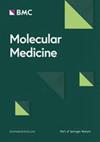整合素αVβ3拮抗剂-c(RGDyk)肽通过抑制成骨和血管生成来减慢后纵韧带骨化的进程
IF 6
2区 医学
Q1 BIOCHEMISTRY & MOLECULAR BIOLOGY
引用次数: 0
摘要
后纵韧带骨化症(OPLL)是一种新出现的异位骨化疾病,会导致脊髓受压,造成运动和感觉功能障碍。OPLL 的病因尚不清楚,但可能涉及调节成骨和血管生成过程的整合素 αVβ3。在本研究中,我们重点研究了整合素αVβ3在OPLL中的作用,并探讨了c(RGDyk)肽作为一种强效、选择性的整合素αVβ3抑制剂抑制OPLL成骨和血管生成的内在机制。手术中采集 OPLL 或对照组韧带样本。OPLL样本的RNA测序结果显示整合素家族被激活,尤其是整合素αVβ3。通过 qPCR、Western 印迹和免疫组化分析检测了整合素 αVβ3 的表达。荧光显微镜观察了c(RGDyk)肽对OPLL患者韧带成纤维细胞(LFs)和内皮细胞(ECs)整合素αVβ3的靶向抑制作用。采用 qPCR 和 Western 印迹法检测了 c(RGDyk)肽对致病 LFs 骨化的影响。碱性磷酸酶染色或茜素红染色用于检测成骨能力。c(RGDyk)肽对血管生成的影响是通过EC迁移和管形成试验确定的。c(RGDyk) 肽对异位骨形成的影响通过体内显微 CT、组织学、免疫组织化学和免疫荧光分析进行了评估。结果表明,经 c(RGDyk)处理后,LFs 的成骨分化明显降低。此外,c(RGDyk)肽还抑制了EC的迁移,从而阻止了成骨所需的营养支持。此外,c(RGDyk)肽还抑制了小鼠异位骨的形成。机理分析表明,c(RGDyk)肽可通过靶向整合素αVβ3和调节FAK/ERK通路来抑制OPLL的成骨和血管生成。因此,整合素αVβ3似乎是OPLL的一个新兴治疗靶点,而c(RGDyk)肽具有双重抑制作用,可能对OPLL的新治疗策略具有重要价值。本文章由计算机程序翻译,如有差异,请以英文原文为准。
Integrin αVβ3 antagonist-c(RGDyk) peptide attenuates the progression of ossification of the posterior longitudinal ligament by inhibiting osteogenesis and angiogenesis
Ossification of the posterior longitudinal ligament (OPLL), an emerging heterotopic ossification disease, causes spinal cord compression, resulting in motor and sensory dysfunction. The etiology of OPLL remains unclear but may involve integrin αVβ3 regulating the process of osteogenesis and angiogenesis. In this study, we focused on the role of integrin αVβ3 in OPLL and explored the underlying mechanism by which the c(RGDyk) peptide acts as a potent and selective integrin αVβ3 inhibitor to inhibit osteogenesis and angiogenesis in OPLL. OPLL or control ligament samples were collected in surgery. For OPLL samples, RNA-sequencing results revealed activation of the integrin family, particularly integrin αVβ3. Integrin αVβ3 expression was detected by qPCR, Western blotting, and immunohistochemical analysis. Fluorescence microscopy was used to observe the targeted inhibition of integrin αVβ3 by the c(RGDyk) peptide on ligaments fibroblasts (LFs) derived from patients with OPLL and endothelial cells (ECs). The effect of c(RGDyk) peptide on the ossification of pathogenic LFs was detected using qPCR, Western blotting. Alkaline phosphatase staining or alizarin red staining were used to test the osteogenic capability. The effect of the c(RGDyk) peptide on angiogenesis was determined by EC migration and tube formation assays. The effects of the c(RGDyk) peptide on heterotopic bone formation were evaluated by micro-CT, histological, immunohistochemical, and immunofluorescence analysis in vivo. The results indicated that after being treated with c(RGDyk), the osteogenic differentiation of LFs was significantly decreased. Moreover, the c(RGDyk) peptide inhibited the migration of ECs and thus prevented the nutritional support required for osteogenesis. Furthermore, the c(RGDyk) peptide inhibited ectopic bone formation in mice. Mechanistic analysis revealed that c(RGDyk) peptide could inhibit osteogenesis and angiogenesis in OPLL by targeting integrin αVβ3 and regulating the FAK/ERK pathway. Therefore, the integrin αVβ3 appears to be an emerging therapeutic target for OPLL, and the c(RGDyk) peptide has dual inhibitory effects that may be valuable for the new therapeutic strategy of OPLL.
求助全文
通过发布文献求助,成功后即可免费获取论文全文。
去求助
来源期刊

Molecular Medicine
医学-生化与分子生物学
CiteScore
8.60
自引率
0.00%
发文量
137
审稿时长
1 months
期刊介绍:
Molecular Medicine is an open access journal that focuses on publishing recent findings related to disease pathogenesis at the molecular or physiological level. These insights can potentially contribute to the development of specific tools for disease diagnosis, treatment, or prevention. The journal considers manuscripts that present material pertinent to the genetic, molecular, or cellular underpinnings of critical physiological or disease processes. Submissions to Molecular Medicine are expected to elucidate the broader implications of the research findings for human disease and medicine in a manner that is accessible to a wide audience.
 求助内容:
求助内容: 应助结果提醒方式:
应助结果提醒方式:


